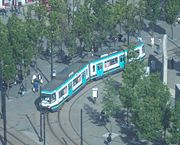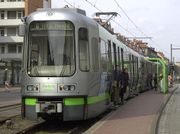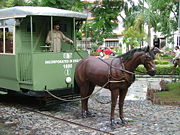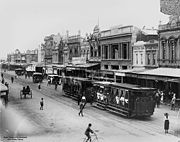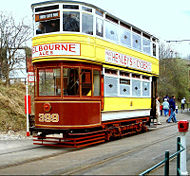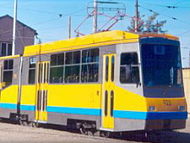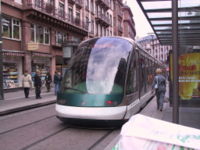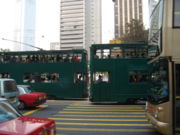Tram
2008/9 Schools Wikipedia Selection. Related subjects: Road transport
| Rail transport |
|---|
| Operations |
| Stations |
| Trains |
| Locomotives |
| Rolling stock |
| History |
| History by country |
| Terminology |
| By country |
| Accidents |
|
Modelling |
|
|
A tram, tramcar, trolley, trolley car, or streetcar is a railborne vehicle, lighter than a train, designed for the transport of passengers (and/or, very occasionally, freight) within, close to, or between villages, towns and/or cities, primarily on streets.
Tram systems (or "tramways" or "street railways") were common throughout the industrialized world in the late 19th and early 20th centuries, but they disappeared from many cities in the mid-20th century. In recent years, they have made a comeback. Many newer light rail systems share features with trams, although a distinction is usually drawn between the two, especially if the line has significant off-street running.
Use of the term
The terms "tram" and "tramway" were originally Scots and Northern English words for the type of truck used in coal mines and the tracks on which they ran — probably derived from the North Sea Germanic word "trame" of unknown origin meaning the "beam or shaft of a barrow or sledge", also "a barrow" or container body.
Although "tram" and "tramway" have been adopted by many languages, they are not used universally in English, North Americans preferring "trolley", "trolley car" or "streetcar". The term "streetcar" is first recorded in 1860, and is a North American usage, as is "trolley," which is believed to derive from the "troller," a four wheeled device that was dragged along dual overhead wires by a cable that connected the troller to the top of the car and collected electrical power from the overhead wire, sometimes simply strung, sometimes on a catenary. The trolley pole, which supplanted the troller early-on, is fitted to the top of the car and is spring-loaded in order to keep the trolley wheel, at the upper of the pole, firmly in contact with the overhead wire. The terms trolley pole and trolley wheel both derive from the troller.
Modern trolleys often do not use a trolley wheel: either they have a metal shoe with a carbon insert or they dispense with the trolley pole completely and have instead a pantograph. Other streetcars are sometimes called trolleys, even though strictly this may be incorrect: cable cars, for example, or conduit cars that draw power from an underground supply.
Tourist buses made to look like streetcars are also sometimes called trolleys; see tourist trolley. Likewise, open, low-speed segmented vehicles on rubber tires, generally used to ferry tourists short distances, can be called trams, particularly in the U.S.; a famous example is the tram on the Universal Studios tour.
Electric buses, which still overwhelmingly use twin trolley poles (one for live current, one for return) are called trolleybuses, trackless trolleys (particularly in the U.S.), or sometimes also trolleys.
History
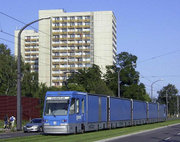
The very first tram (streetcar) was the Mumbles Railway (Swansea to Mumbles, Wales, UK) it was horse drawn at first and later by steam power and then electric. The Mumbles Railway Act 1804 was passed by the British Parliament, and the first passenger railway (which acted like streetcars did in the US some 30 years later) started operating in 1807.
The first streetcars, also known as horsecars in North America, were built in the United States and developed from city stagecoach lines and omnibus lines that picked up and dropped off passengers on a regular route and without the need to be pre-hired. These trams were an animal railway, usually using horses and sometimes mules to haul the cars, usually two as a team. Rarely other animals were tried, including humans in emergencies. The first streetcar - the New York and Harlem Railroad's Fourth Avenue Line - ran along the Bowery and Fourth Avenue in New York City, and began service in the year 1832. It was followed in 1835 by New Orleans, Louisiana, which is the oldest continuously operating street railway system in the world, according to the American Society of Mechanical Engineers. At first the rails protruded above street level, causing accidents and major trouble for pedestrians. They were supplanted in 1852 by grooved rails or girder rails, invented by Alphonse Loubat. The first tram in Paris, France, was inaugurated in 1853 for the upcoming World's Fair, where a test line was presented along the Cours de la Reine, in the 8th arrondissement.
One of the advantages over earlier forms of transit was the low rolling resistance of metal wheels on steel rails, allowing the animals to haul a greater load for a given effort. Problems included the fact that any given animal could only work so many hours on a given day, had to be housed, groomed, fed and cared for day in and day out, and produced prodigious amounts of manure, which the streetcar company was charged with disposing of. Since a typical horse pulled a car for perhaps a dozen miles a day and worked for four or five hours, many systems needed ten or more horses in stable for each horsecar. Electric trams largely replaced animal power in the late 19th and early 20th century. New York City had closed its last horsecar line in 1917. The last regular mule drawn streetcar in the U.S.A., in Sulphur Rock, Arkansas, closed in 1926. However during World War II some old horse cars were temporarily returned to service to help conserve fuel. A mule-powered line in Celaya, Mexico, operated until 1956. Horse-drawn trams still operate in Douglas, Isle of Man. There is also a small line operated on Main Street at DisneyWorld, outside of Orlando Florida. A small horse-drawn service operates every 40 minutes at Victor Harbour, South Australia, daily with 20 minute services during tourist seasons. This service runs between the mainland and Granite Island across a causeway.
The tram developed after that in numerous cities of Europe (London, Berlin, Paris, etc.) and Asia ( Kyoto, Tokyo, Hong Kong). Faster and more comfortable than the omnibus, trams had a high cost of operation because they were pulled by horses. That is why mechanical drives were rapidly developed, with steam power in 1873, and electrical after 1881, when Siemens AG presented the electric drive at the International Electricity Exhibition in Paris.
The convenience and economy of electricity resulted in its rapid adoption once the technical problems of production and transmission of electricity were solved. The first prototype of the electric tram was developed by Russian engineer Fyodor Pirotsky. He modified a Horse tramway car to be powered by electricity instead of horses. The invention was tested in 1880 in Saint Petersburg, Russia. The world's first electric tram line opened in Lichterfelde near Berlin, Germany, in 1881. It was built by Werner von Siemens. (see Berlin Straßenbahn).
In Japan, the Kyoto Electric railroad was the first tram system, starting operation in 1865. By 1932, the network had grown to 82 railway companies in 65 cities, with a total network length of 1,479km. By the 1960s, however, the tram had generally died out in Japan.
History of the different types of tram
Horse-drawn trams
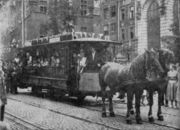
In the nineteenth century Calcutta (now Kolkata) was developing fast as a British trading and business centre. Transport was mainly by palanquins carried on men's shoulders, phaetons pulled by horses, etc. In 1867, The Calcutta Corporation, with financial assistance from the Government of Bengal developed mass transport. The first tramcar rolled out on the streets of Calcutta on February 24, 1873, with horse drawn coaches running on steel rails between Sealdah and Armenian Ghat via Bowbazar and Dalhousie Square, (now B. B. D. Bagh). The Corporation entered into an agreement on February 10, 1879 with three English industrial magnates: Robinson Soutter, Alfred Parrish and Dilwyn Parrish. Registered in London, the Calcutta Tramways Company came into existence in 1880 after the sanction of The Calcutta Tramways Act, 1880.
By 1902 Messrs Kilburn & Co completed the electrification of the Calcutta tramways and the first electric tramcar was introduced in the Kidderpore section.
Calcutta remains the only Indian city which has maintained tramway system. As of now, it remains an unreliable but very comfortable and eco-friendly transport.
Steam trams
The first mechanical trams were operated using mobile steam engines. Generally, there were two types of steam tram. The first and most common had a small steam locomotive (called a tram engine in the UK) at the head of a line of one or more carriages, similar to a small train. Systems with such steam trams included Christchurch, New Zealand, Sydney, Australia, and other provincial city systems in New South Wales.
The other style of steam tram had the steam engine mounted in the body of the tram. The most notable system to adopt such trams was in Paris. French-designed steam trams also operated in Rockhampton, in the Australian state of Queensland between 1909 and 1939. Stockholm, Sweden, also had a steam tramline at the island of Södermalm between 1887 and 1901. A major drawback of this style of tram was the limited space for the engine, so that these trams were usually underpowered.
Cable pulled cars
The next type of tram was the cable car, which sought to reduce labor costs and the hardship on animals. Cable cars are pulled along a rail track by a continuously moving cable running at a constant speed on which individual cars stop and start by releasing and gripping this cable as required. The power to move the cable is provided at a site away from the actual operation. The first cable car line in the United States was tested in San Francisco, California, in 1873. The second city to operate cable trams was Dunedin in New Zealand in 1881. Dunedin's cable trams ceased operation in 1957.
Cable cars suffered from high infrastructure costs, since a vast and expensive system of cables, pulleys, stationary engines and vault structures between the rails had to be provided. They also require strength and skill to operate, to avoid obstructions and other cable cars. The cable had to be dropped at particular locations and the cars coast, for example when crossing another cable line. Breaks and frays in the cable, which occurred frequently, required the complete cessation of services over a cable route, while the cable was repaired. After the development of electrically-powered trams, the more costly cable car systems declined rapidly.
Cable cars were especially useful in hilly cities, partially explaining their survival in San Francisco, though the most extensive cable system in the U.S. was in Chicago, a much flatter city. The largest cable system in the world which operated in the flat city of Melbourne, Victoria, Australia, had, at its peak, 592 trams running on 74 kilometres of track.
The San Francisco cable cars, though significantly reduced in number, continue to perform a regular transportation function, in addition to being a tourist attraction. Single lines also survive on hilly parts of Wellington, New Zealand (rebuilt in 1979 to a funicular system but still called the ' Wellington Cable Car') and Hong Kong.
Electric trams (trolley cars)

Multiple functioning experimental electric trams were exhibited at the 1884 World Cotton Centennial World's Fair in New Orleans, Louisiana; however they were deemed as not yet adequately perfected to replace the Lamm fireless engines then propelling the St. Charles Avenue Streetcar in that city.
Electric-powered trams ( trolley cars, so called for the trolley pole used to gather power from an unshielded overhead wire), were first successfully tested in service in Richmond, Virginia, in 1888, in the Richmond Union Passenger Railway built by Frank J. Sprague. There were earlier commercial installations of electric streetcars, including one in Berlin, as early as 1881 by Werner von Siemens and the company that still bears his name, and also one in Saint Petersburg, Russia, invented and tested by Fyodor Pirotsky in 1880. Another was by John Joseph Wright, brother of the famous mining entrepreneur Whitaker Wright, in Toronto in 1883. The earlier installations, however, proved difficult and/or unreliable. Siemens' line, for example, provided power through a live rail and a return rail, like a model train setup, limiting the voltage that could be used, and providing unwanted excitement to people and animals crossing the tracks. Siemens later designed his own method of current collection, this time from an overhead wire, called the bow collector. Once this had been developed his cars became equal to, if not better than, any of Sprague's cars. The first electric interurban line connecting St. Catharines and Thorold, Ontario was operated in 1887, and was considered quite successful at the time. While this line proved quite versatile as one of the earliest fully functional electric streetcar installations, it still required horse-drawn support while climbing the Niagara Escarpment and for two months of the winter when hydroelectricity was not available. This line continued service in its original form well into the 1950s.
Since Sprague's installation was the first to prove successful in all conditions, he is credited with being the inventor of the trolley car. He later developed Multiple unit control, first demonstrated in Chicago in 1897, allowing multiple cars to be coupled together and operated by a single motorman. This gave birth to the modern subway train.
Two rare but significant alternatives were conduit current collection, which was widely used in London, Washington, D.C. and New York, and the Surface Contact Collection method, used in Wolverhampton (The Lorain System) and Hastings (The Dolter Stud System), UK.
Attempts to use on-board batteries as a source of electrical power were made from the 1880s and 1890s, with unsuccessful trials conducted (among other places) in Bendigo and Adelaide in Australia, although run for about 14 years as Hague accutram of HTM in the Netherlands.
A very famous Welsh example of a tram system was usually known as the Mumbles Train, or more formally as the Swansea and Mumbles Railway. Originally built as the Oystermouth Railway in 1804, on March 25, 1807 it became the first passenger-carrying railway in the world. Converted to an overhead cable-supplied system it operated electric cars from March 2, 1929 until its closure on January 5, 1960. These were the largest tram cars built for use in Britain and could each seat 106 passengers.
Another early tram system operated from 1886 until 1930 in Appleton, Wisconsin, and is notable for being powered by the world's first hydroelectric power station, which began operating on September 30, 1882 as the Appleton Edison Electric Company.
There is one particular hazard associated with trams powered from a trolley off an overhead line. Since the tram relies on contact with the rails for the current return path, a problem arises if the tram is derailed or (more usually) if it halts on a section of track that has been particularly heavily sanded by a previous tram, and the tram loses electrical contact with the rails. In this event, the main chassis of the tram, by virtue of a circuit path through ancillary loads (such as saloon lighting), is live by the full supply voltage (typically 600 volts) relative to the running rails (and indeed the surrounding earthed land). In British terminology such a tram was said to be 'grounded' - not to be confused with the US English use of the term which means the exact opposite. Any person stepping off the tram completed the earth return circuit and could receive a nasty electric shock. In such an event the driver was required to jump off the tram (avoiding simultaneous contact with the tram and the ground) and pull down the trolley before allowing passengers off the tram. Unless derailed, the tram could usually be recovered by running water down the running rails from a point higher than the tram. The water providing a conducting bridge between the tram and the rails.
Low floor
- and Ultra Low Floor
The latest generation of LRVs has the advantage of partial or fully low-floor design, with the floor of the vehicles only 300 to 360 mm (12-14 inches) above top of rail, a capability not found in either rapid rail transit vehicles or streetcars. This allows them to load passengers, including ones in wheelchairs, directly from low-rise platforms that are not much more than raised sidewalks. This satisfies requirements to provide access to disabled passengers without using expensive wheelchair lifts, while at the same time making boarding faster and easier for other passengers as well. The City Class LRV (Citytram) is one example of a low floored vehicle, 300 mm above rail height, with 70% of the 29 m long and 75% of the 38 m long versions low floor. The low floor extends across the articulation. The City Class has been designed to operate around 15 m curves and climb 10% gradients, and therefore allow new systems to be built in existing urban streets without the need to demolish buildings.
Articulated
Articulated trams are tram cars that consist of several sections held together by flexible joints and a round platform. Like articulated buses, they have an increased passenger capacity. These trams can be up to forty metres in length, while a regular tram has to be much shorter. With this type, a Jacobs bogie supports the articulation between the two or more carbody sections. An articulated tram may be low floor variety or high (regular) floor variety. Since 1981 onwards, nearly 150 articulated LRV-trams of the last kind are e.g. to be found in The Hague Netherlands.
Ref.: HTM LRV nl:GTL8 / D.A. Borgdorff / The Hague - 2000 / ISBN 9090139354
Tram-train
Tram-train operation uses vehicles such as the Flexity Link and Regio- Citadis which are suited for use on urban tram lines, but also meet the necessary indication, power, and resistance requirements to be certified for operation on main line railways. This allows passengers to travel from suburban areas into city-centre destinations without having to change from a train to a tram when they arrive at the central station.
It has been primarily developed in Germanic countries, in particular Germany and Switzerland. Karlsruhe is a notable pioneer of the tram-train.
Cargo trams
Goods have been carried on rail vehicles through the streets, particularly near docks and steelworks, since the 19th century (most evident in Weymouth), and some Belgian vicinale routes were used to haul timber. At the turn of the 21st century, a new interest has arisen in using urban tramway systems to transport goods. The motivation now is to reduce air pollution, traffic congestion and damage to road surfaces in city centres. Dresden has a regular CarGoTram service, run by the world's longest tram trainsets (59.4 m), carrying car parts across the city centre to its Volkswagen factory. Vienna and Zürich use trams as mobile recycling depots. Kislovodsk had a freight-only tram system comprising one line which was used exclusively to deliver bottled Narzan mineral water to the railway station.
As of 7 March 2007, Amsterdam is piloting a cargo tram operation, which could reduce particulate pollution by 20% by halving the number of lorries – currently 5,000 - unloading in the inner city during the permitted timeframe from 07:00 till 10:30.
The pilot, operated by City Cargo Amsterdam, involves two cargo trams, operating from a distribution centre at Lutkemeerpolder, on the A9 ring motorway near the Osdorp terminus of tram no. 1. Each cargo tram can transport the load of 4 lorries (roughly 100 tonnes) to a ‘hub’ at Frederiksplein, where electric trucks deliver to the final destination.
If the trial is successful an investment of 100 million euro would see a fleet of 52 cargo trams distributing from four peripheral ‘cross docks’ to 15 inner-city hubs by 2012. These specially-built vehicles would be 30 metres long with 12 axles and a payload of 30 tonnes.
(Source: Samenwest 5 December 6, NOS3 television news 7 March 7)
Model trams
Models of trams are popular in HO scale and sometimes in 1:50 scale. They typically are powered and will accept plastic figures inside. Common manufacturers are Roco and Lima with many custom models being made as well. The German firm Hödl and the Austrian Halling specialize in trams in 1:87 scale.
A number of 1:76.2 scale tram models, especially kits, are made in the UK. Many of these run on 16.5 mm gauge track, which is incorrect for the representation of standard (4ft 8½ins) gauge, as it represents 4ft 1½ins in 4 mm (1:76.2) scale. This scale/gauge hybrid is called OO scale.
There are some Russian tram models available in 1:48 scale
Pros and cons of tram systems
All transit services involves a tradeoff between speed and frequency of stops. Services that stop frequently have a lower overall speed, and are therefore less attractive for longer trips. Metros, light rail, monorail, and bus rapid transit are all forms of rapid transit — which generally signifies high speed and widely-spaced stops. Trams are a form of local transit, making frequent stops. Thus, the most meaningful comparison of advantages and disadvantages is with other forms of local transit, primarily the local bus.
Advantages
- Multiple entrances allow trams to load faster than suburban coaches, which tend to have a single entrance. This, combined with swifter acceleration and braking, lets trams maintain higher overall speeds than buses, if congestion allows.
- Trams can adapt to the number of passengers by adding additional cars during rush hour (as well as removing excess cars during off-peak hours). No additional driver is then required for the trip in comparison to buses.
- In general, trams provide a higher capacity service than buses.
- Unlike buses, but like trolleybuses, (electric) trams give off no exhaust emissions at point of use. Compared to motorbuses the noise of trams is generally perceived to be less disturbing.
- Rights-of-way for trams are narrower than for buses. This saves valuable space in cities with high population densities and/or narrow streets.
- Because they are rail-bound, trams command more respect from other road users than buses do, when operating on-road. In heavy traffic conditions, rogue drivers are less likely to hold up trams, for example by blocking intersections or parking on the road. This often leads to fewer delays. As a rule, especially in European cities and Melbourne, trams always have priority.
- Passenger comfort is normally superior to buses because of controlled acceleration and braking and curve easement. Rail transport such as used by trams provides a smoother ride than road use by buses.
- In most countries, trams don't suffer from the image problem that plagues buses. On the contrary — most people associate trams with a positive image. Unlike buses, trams tend to be popular with a wider spectrum of the public, including better-off people who often shun buses. This high level of customer acceptance means higher patronage and greater public support for investment in new tram infrastructure.
Disadvantages
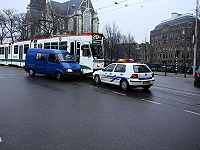
- The capital cost is higher than for buses, hence the usual preference for the latter in smaller cities
- When operated in mixed traffic, trams are more likely to be delayed by disruptions in their lane. Buses, by contrast, can easily manoeuvre around obstacles. Opinions differ about whether deference that drivers show to trams — a cultural issue that varies by country — is sufficient to counteract this disadvantage.
- Tram tracks can be dangerous for cyclists, as bikes, particularly those with narrow tyres, may get their wheels caught in the track grooves. It is also possible to close the grooves of the tracks on critical sections by rubber profiles that are pressed down by the wheelflanges of the passing tram, but cannot be lowered by the weight of a cyclist. These tend not to be maintained, lessening their effectiveness over time. Crossing tracks without trouble requires a sufficient angle of crossing, reducing a cyclists' ability to avoid road hazards where tracks run along the road, especially in wet weather. This and problems with parked cars are lessened by building tracks and platforms in the middle of the road.
- Tram infrastructure occupies urban space above ground and requires modifications to traffic flow.
- Steel wheel trams are noisier than rubber-wheeled trolleybuses when cornering if there are no additional measures taken (e.g. greasing wheelflanges, which is standard in new-built systems).
- Tram drivers can control the switches ahead of them. This caused a major derailment in Geneva, Switzerland. A Wikinews article on the derailment In modern tram systems this problem has been resolved by use of switches that inhibit relocation when a tram is detected passing and/or more sophisticated means of command transmission.
- In urban areas where stops are close together, trams tend to coast between stops.
- Light rail vehicles are often heavier per passenger carried than heavy rail and monorail cars.
- The opening of new tram and light rail systems has sometimes been accompanied by a marked increase in car accidents, as a result of drivers' unfamiliarity with the physics and geometry of trolleys. Though such increases may be temporary, long-term conflicts between motorists and light rail operations can be alleviated by segregating their respective rights-of-way and installing appropriate signage and warning systems.
- Rail transport can expose neighboring populations to moderate levels of low-frequency noise. However, transportation planners use noise mitigation strategies to minimize these effects. Most of all, the potential for decreased private motor vehicle operations along the trolley's service line due to the service provision could result in lower ambient noise levels than without.
On Balance
Many of the pros and cons depend on the system design itself. A tram system with little distance between stops that has single unit vehicles which run in mixed traffic will see far less of an advantage over other transit alternatives than a tram system with a greater distance between stops, runs in multiple units, and runs in a dedicated right of way. Overall trams have a greater versatility in design, however as shown above, whether that is a pro or a con is debatable.
Tram and light-rail transit systems around the world
Around the world there are many tram systems; some date back from the early 20th century but countless number of the old systems were closed down with the exception of many Eastern Europe countries in the mid-20th century. Even though many of the systems have closed down over the years there are still tram systems that have been operating much as they did when they were first built over a century ago. Some cities that have once closed down their tram networks are now in the stages of reconstructing their tramways.
Tram manufacturers
- Crotram
 Croatia
Croatia - Bombardier Transportation
 Canada
Canada- Urban Transportation Development Corporation 1973-1990s
- Hawker Siddeley Canada 1962-2001
- Russell Car Company
- J. G. Brill and Company
- American Car Company
- Ottawa Car Company
- St. Louis Car Company
- Canadian Car and Foundry
- Siemens
 Germany
Germany - Ansaldobreda
 Italy
Italy - Firema Transporti SpA
- Alstom
 France
France - TDI
- CAF
 Spain
Spain - Tatra
 Czech Republic
Czech Republic - Škoda
 Czech Republic
Czech Republic - Stadler
 Switzerland
Switzerland - Dick, Kerr & Co.
 England
England - English Electric
 England
England - Hong Kong Tramways
 Hong Kong
Hong Kong
Trams in literature
One of the earliest literary references to trams occurs on the second page of Henry James's novel The Europeans:
- From time to time a strange vehicle drew near to the place where they stood - such a vehicle as the lady at the window, in spite of a considerable acquaintance with human inventions, had never seen before: a huge, low, omnibus, painted in brilliant colours, and decorated apparently with jingling bells, attached to a species of groove in the pavement, through which it was dragged, with a great deal of rumbling, bouncing, and scratching, by a couple of remarkably small horses.
Published in 1878, the novel is set in the 1840s, though horse trams were not in fact introduced in Boston till the 1850s. Note how the tram's efficiency surprises the "European" visitor; how two "remarkably small" horses sufficed to draw the "huge" tramcar.
Gdansk trams figure extensively in the early stages of Günter Grass's Die Blechtrommel ( The Tin Drum). Then in its last chapter, the novel's hero Oskar Matzerath, along with his friend Gottfried von Vittlar, steal a tram late at night from outside the Unterrath depot on the northern edge of Düsseldorf.
It is a surreal journey. Gottfried von Vittlar drives the tram through the night, south to Flingern and Haniel and then east to the suburb of Gerresheim. Meanwhile, inside, Oskar tries to rescue the half-blind Victor Weluhn (a character who had escaped from the siege of the Polish post office in Danzig at the beginning of the book and of the war) from his two green-hatted would-be executioners. Oskar deposits his briefcase, which contains Sister Dorotea's severed ring finger in a preserving jar, on the dashboard "where professional motorman put their lunchboxes". They leave the tram at the terminus, and the executioners tie Weluhn to a tree in Vittlar's mother's garden and prepare to machine-gun him. But Oskar drums, Victor sings, and together they conjure up the Polish cavalry, who spirit both victim and executioners away. Oskar asks Vittlar to take his briefcase in the tram to the police HQ in the Fürstenwall, which he does.
The latter part of this route is today served by tram no. 703 terminating at Gerresheim Stadtbahn station ("by the glassworks" as Grass notes, referring to the famous glass factory in Gerresheim).
[Reference: The chapter Die letzte Straßenbahn oder Anbetung eines Weckglases (The last tram or Adoration of a Preserving Jar). See page 584 of the 1959 Büchergilde Gutenberg German edition and page 571 of the 1961 Secker & Warburg edition, translated into English by Ralph Manheim]
Trams in popular culture
- The Rev W. Awdry made a small LNER J70 tram called Toby the Tram Engine which starred in a series of books called The Railway Series along with his faithful coach, Henrietta.
- A Streetcar Named Desire (play)
- A Streetcar Named Desire (film)
- Mister Roger's Neighbourhood featured a trolley
- The central plot of the film Who Framed Roger Rabbit involves the Judge Doom, the villain, dismantling the streetcars of Los Angeles.
- "The Trolley Song" in Meet Me in St. Louis (film) received an Academy Award.
- The 1944 World Series was also known as the "Streetcar Series".
- Malcolm (film) - an Australian film about a tram enthusiast who uses his inventions to pull off a bank heist.
- Luis Bunuel filmed La Ilusión viaja en tranvía (English: Illusion Travels by Stretcar) in Mexico in 1954
- In Akira Kurosawa's film Dodesukaden a mentally ill boy pretends to be a tram conductor.
- The predominance of trams (trolleys) gave rise to the disparaging term trolley dodger for residents of the borough of Brooklyn in New York City. That term, shortened to "Dodger" became the nickname for the Brooklyn Dodgers (now the Los Angeles Dodgers).

